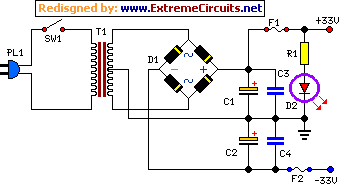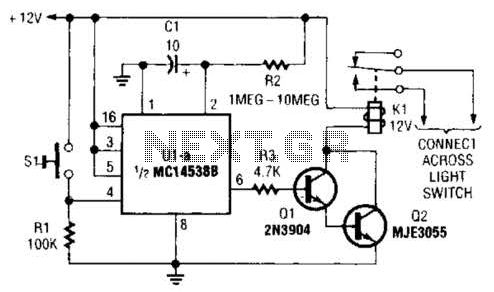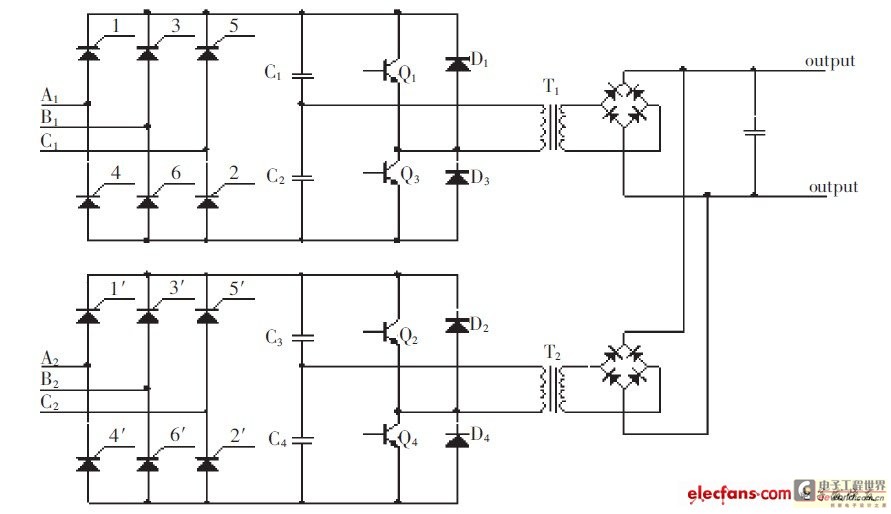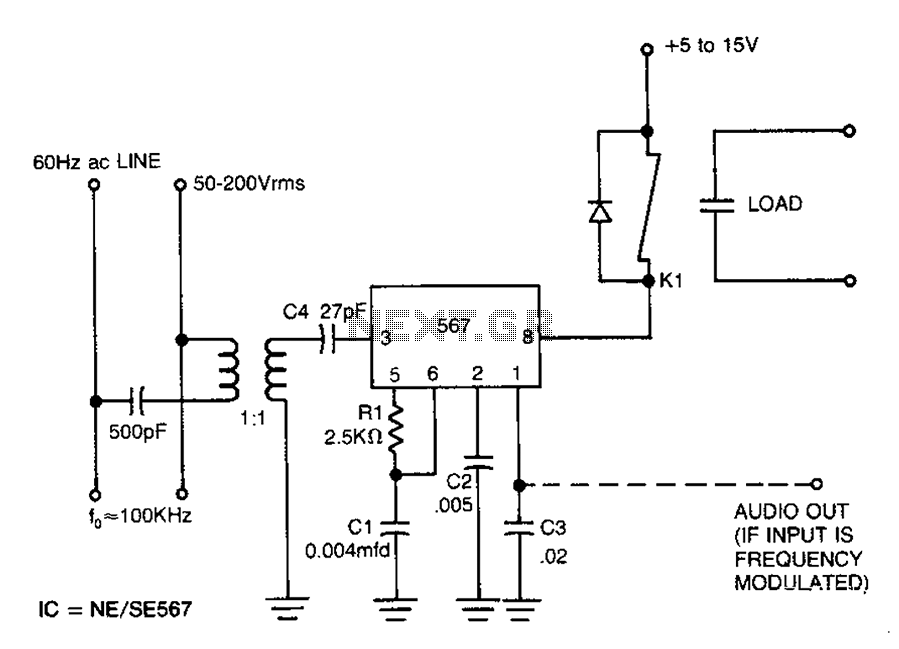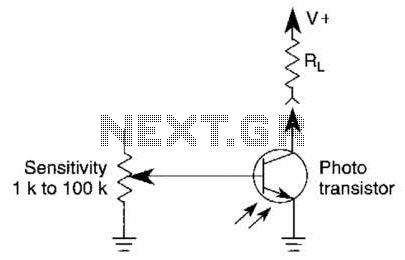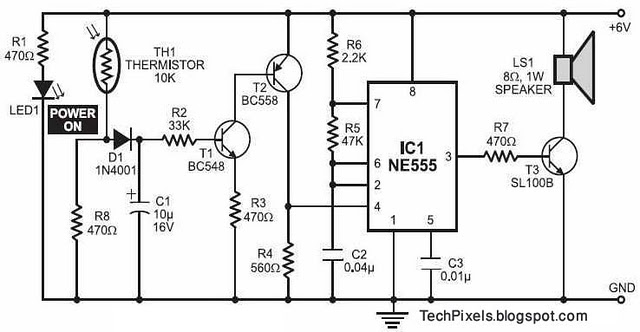
5V Power Supply Circuit Using Overvoltage Protection

This design outlines a power supply circuit capable of producing a 5V source voltage. The circuit is constructed using TTL integrated circuits (ICs) and features a simple design. In circuits utilizing TTL ICs, the supply voltage is critical, as even a slight increase beyond the rated 5V can damage the ICs. Relying solely on fuses is inadequate, as they can take several milliseconds to blow, which may result in damage to the ICs. To mitigate this issue, a crowbar scheme is implemented, where a triac short circuits the power supply and burns the fuse. The time taken for the fuse to burn is not a concern because the triac already shorts the power supply, resulting in a zero output voltage. The circuit operates such that when the output voltage exceeds 5.6 volts, the zener diode D2 conducts and activates the triac T1. In this state, T1 functions as a closed switch, shorting the circuit and causing the output voltage to drop to zero while the fuse burns out. The trip voltage can be adjusted by changing the values of D2 and R2. Since the triac's switching occurs within a few microseconds, there is no risk of damage to TTL ICs or other voltage-sensitive components in the load circuit. For transformer specifications, T1 should be a 230V AC primary with a 12V secondary rated at 2A. All capacitors must have a minimum voltage rating of 25V. If a 1A bridge rectifier is not available, it can be constructed using four 1N4007 diodes.
The power supply circuit is designed to ensure the protection of TTL ICs from overvoltage conditions by employing a crowbar protection scheme. The circuit includes a transformer with a primary winding rated for 230V AC and a secondary winding that outputs 12V at 2A. This transformer steps down the high voltage AC supply to a lower voltage suitable for the TTL ICs.
The key components of the circuit include a zener diode (D2), which serves as a voltage reference. When the output voltage exceeds 5.6V, the zener diode begins to conduct, triggering the triac (T1). The triac is a semiconductor device that can control large amounts of current with a small gate trigger. Once activated, T1 creates a short circuit across the power supply, effectively cutting off the voltage supplied to the load and allowing the fuse to burn out, thereby protecting sensitive components.
The trip voltage, which determines when the circuit will activate the triac, can be adjusted by changing the resistance value of R2 or the zener diode D2. This flexibility allows for fine-tuning of the circuit to accommodate different load conditions or specific requirements of the application.
The use of a fuse in conjunction with the triac provides a fail-safe mechanism. While the fuse typically takes longer to react, the immediate action of the triac ensures that no harmful voltage is present during this delay. The design emphasizes reliability and safety, making it suitable for environments where TTL ICs are used.
Capacitors in the circuit must be rated for at least 25V to handle potential voltage spikes without failure. If a pre-assembled bridge rectifier rated at 1A is not available, it can be constructed using four 1N4007 diodes, which are standard rectifier diodes known for their robustness and reliability in various applications. This design ensures that the power supply circuit remains effective and safe for use with TTL ICs and similar sensitive electronic components.This is a design for power supply circuit. This circuit can produce source voltage 5V. This circuit is built by TTL IC`s. But this design is simple design. This is the figure of the circuit. For circuits using TTL ICs the supply voltage is a great concern and a slight increase in supply from the rated 5V may damage the IC. Using fuses alone does n ot solve the problem because a fuse may take several milliseconds to blow off and that`s enough time for the IC to get damaged. In this circuit a crowbar scheme is used in which a triac short circuits the power supply and burns the fuse.
The burning time of the fuse is not a concern because the power supply is already shorted by the triac and the output voltage will be zero. Operation of the circuit is when the output voltage exceeds 5. 6 volts the zener diode D2 conducts and switches ON the triac T1. Now T1 acts as a closed switch, shorting the circuit. The output voltage drops to zero and fuse gets burned off. The trip voltage can be varied by varying the values of D2 and R2. Since the switching of triac takes place within few micro seconds there will be no damage to the TTL ICs or any other such voltage sensitive components in the load circuit.
For the transformer T1 can be a 230 V AC primary, 12v secondary, 2A step-down transformer. All capacitors must be rated at least 25V. If 1A Bridge is not available, make one using four 1N4007 diodes. 🔗 External reference
The power supply circuit is designed to ensure the protection of TTL ICs from overvoltage conditions by employing a crowbar protection scheme. The circuit includes a transformer with a primary winding rated for 230V AC and a secondary winding that outputs 12V at 2A. This transformer steps down the high voltage AC supply to a lower voltage suitable for the TTL ICs.
The key components of the circuit include a zener diode (D2), which serves as a voltage reference. When the output voltage exceeds 5.6V, the zener diode begins to conduct, triggering the triac (T1). The triac is a semiconductor device that can control large amounts of current with a small gate trigger. Once activated, T1 creates a short circuit across the power supply, effectively cutting off the voltage supplied to the load and allowing the fuse to burn out, thereby protecting sensitive components.
The trip voltage, which determines when the circuit will activate the triac, can be adjusted by changing the resistance value of R2 or the zener diode D2. This flexibility allows for fine-tuning of the circuit to accommodate different load conditions or specific requirements of the application.
The use of a fuse in conjunction with the triac provides a fail-safe mechanism. While the fuse typically takes longer to react, the immediate action of the triac ensures that no harmful voltage is present during this delay. The design emphasizes reliability and safety, making it suitable for environments where TTL ICs are used.
Capacitors in the circuit must be rated for at least 25V to handle potential voltage spikes without failure. If a pre-assembled bridge rectifier rated at 1A is not available, it can be constructed using four 1N4007 diodes, which are standard rectifier diodes known for their robustness and reliability in various applications. This design ensures that the power supply circuit remains effective and safe for use with TTL ICs and similar sensitive electronic components.This is a design for power supply circuit. This circuit can produce source voltage 5V. This circuit is built by TTL IC`s. But this design is simple design. This is the figure of the circuit. For circuits using TTL ICs the supply voltage is a great concern and a slight increase in supply from the rated 5V may damage the IC. Using fuses alone does n ot solve the problem because a fuse may take several milliseconds to blow off and that`s enough time for the IC to get damaged. In this circuit a crowbar scheme is used in which a triac short circuits the power supply and burns the fuse.
The burning time of the fuse is not a concern because the power supply is already shorted by the triac and the output voltage will be zero. Operation of the circuit is when the output voltage exceeds 5. 6 volts the zener diode D2 conducts and switches ON the triac T1. Now T1 acts as a closed switch, shorting the circuit. The output voltage drops to zero and fuse gets burned off. The trip voltage can be varied by varying the values of D2 and R2. Since the switching of triac takes place within few micro seconds there will be no damage to the TTL ICs or any other such voltage sensitive components in the load circuit.
For the transformer T1 can be a 230 V AC primary, 12v secondary, 2A step-down transformer. All capacitors must be rated at least 25V. If 1A Bridge is not available, make one using four 1N4007 diodes. 🔗 External reference
